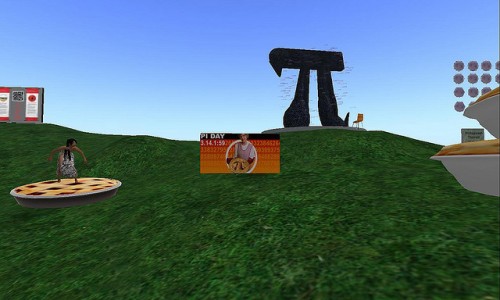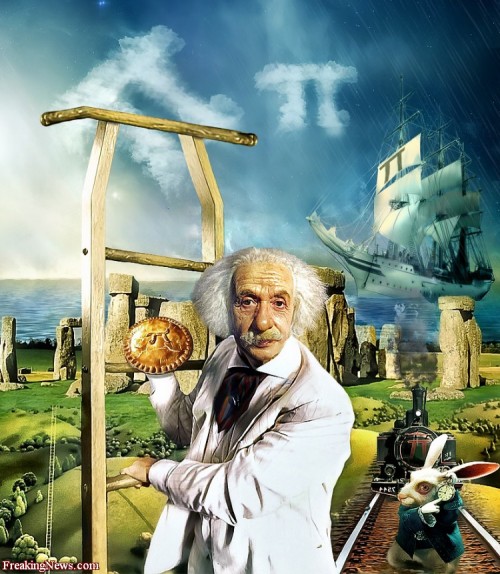Behind the Scenes
Language Is A Pie You Bake In The Sun We Share
Most of the blockquotes, via Wikipedia entries for Mythical origins of language & Origin of language, are slightly edited.
India
A Hindu myth tells of how not only differences in language, but also diversity in culture, or customs, came into being, by the punishment of a proud tree, by the creator-god Brahma.
There grew in the centre of the earth the wonderful `world tree,’ or `knowledge tree.’ It was so tall that it reached almost to heaven. It said in its heart, `I shall hold my head in heaven and spread my branches over all the earth, and gather all men together under my shadow, and protect them, and prevent them from separating.’ But Brahma, to punish the pride of the tree, cut off its branches and cast them down on the earth, when they sprang up as wata trees, and made differences of belief and speech and customs to prevail on the earth, to disperse men upon its surface.
Monogenesis
Linguistic monogenesis is the hypothesis that there was a single proto-language, sometimes called Proto-Human, from which all other languages spoken by humans descend. All human populations possess language. This includes populations, such as the Tasmanians and the Andamanese, who may have been isolated from the Old World continents for as long as 40,000 years. Thus, the multiregional hypothesis would entail that modern language evolved independently on all the continents, a proposition considered implausible by proponents of monogenesis.
According to the Out of Africa hypothesis, all humans alive today are descended from Mitochondrial Eve, a woman estimated to have lived in Africa some 150,000 years ago. This raises the possibility that the Proto-Human language could date to approximately that period. There are also claims of a population bottleneck, notably the Toba catastrophe theory, which postulates human population at one point some 70,000 years ago was as low as 15,000 or even 2,000 individuals. If it did indeed transpire, such a bottleneck would be an excellent candidate for the date of Proto-Human, which also illustrates the fact that Proto-Human would not necessarily date to the first emergence of language.
Africa
The Wa-Sania, a Bantu people of East African origin, have a tale that in the beginning the peoples of the earth knew only one language, but during a severe famine a madness struck the people, causing them to wander in all directions, jabbering strange words, and this is how different languages came about.
Self-domesticated ape theory
According to a study investigating the song differences between white-rumped Munias and its domesticated counterpart (Bengalese finch), the wild munias use a highly stereotyped song, whereas the domesticated ones sing a highly unconstrained song. Considering that song syntactical complexity is subject to female preference in the Bengalese finch, it is likely that maternal resource allocation strategies play a role in song evolution. In the field of bird vocalization, brains capable of producing only an innate song have very simple neural pathways: the primary forebrain motor center, called the robust nucleus of arcopallium (RA), connects to midbrain vocal outputs which in turn project to brainstem motor nuclei. By contrast, in brains capable of learning songs, the RA receives input from numerous additional forebrain regions, including those involved in learning and social experience. Control over song generation has become less constrained, more distributed, and more flexible.
When compared with other primates, whose communication system is restricted to a highly stereotypic repertoire of hoots and calls, humans have very few prespecified vocalizations, extant examples being laughter and sobbing. Moreover, these remaining innate vocalizations are generated by restricted neuronal pathways, whereas language is generated by a highly distributed system involving numerous regions of the human brain.
A salient feature of language is that while language competency is inherited, the languages themselves are transmitted via culture. Also transmitted via culture are understandings, such as technological ways of doing things, that are framed as language-based explanations. Hence one would expect a robust co-evolutionary trajectory between language competency and culture: proto-humans capable of the first, and presumably rudimentary, versions of protolanguage would have better access to cultural understandings, and cultural understandings, conveyed in protolanguages that children’s brains could readily learn, were more likely to be transmitted, thereby conferring the benefits accrued.
Hence proto-humans indubitably engaged in, and continue to engage in, what is called niche construction, creating cultural niches that provide understandings key to survival, and undergoing evolutionary changes that optimize their ability to flourish in such niches. Selection pressures that operated to sustain instincts important for survival in prior niches would be expected to relax as humans became increasingly dependent on their self-created cultural niches, while any innovations that facilitated cultural adaptation—in this case, innovations in language competency—would be expected to spread.
One way to think about human evolution is that we are basically self-domesticated apes. Just as domestication relaxed selection for stereotypic songs in the finches—mate choice was supplanted by choices made by the aesthetic sensibilities of bird breeders and their customers—so might our cultural domestication have relaxed selection on many of our primate behavioral traits, allowing old pathways to degenerate and reconfigure. Given the highly indeterminate way that mammalian brains develop—they basically construct themselves “bottom up,” with one set of neuronal interactions setting the stage for the next round of interactions—degraded pathways would tend to seek out and find new opportunities for synaptic hookups. Such inherited de-differentiations of brain pathways might have contributed to the functional complexity that characterizes human language. And, as exemplified by the finches, such de-differentiations can occur in very rapid timeframes.
Southeast Asia and Oceania
In South Australia, a people of Encounter Bay tell a story of how diversity in language came about from cannibalism:
In remote time an old woman, named Wurruri lived towards the east and generally walked with a large stick in her hand, to scatter the fires around which others were sleeping, Wurruri at length died. Greatly delighted at this circumstance, they sent messengers in all directions to give notice of her death; men, women and children came, not to lament, but to show their joy. The Raminjerar were the first who fell upon the corpse and began eating the flesh, and immediately began to speak intelligibly. The other tribes to the eastward arriving later, ate the contents of the intestines, which caused them to speak a language slightly different. The northern tribes came last and devoured the intestines and all that remained, and immediately spoke a language differing still more from that of the Raminjerar.
Another group of Australian aboriginals, the Gunwinggu, tell of a goddess in dreamtime giving each of her children a language of their own to play with.
The traditional beliefs of the indigenous inhabitants of the Andaman Islands in the Bay of Bengal describe language as being given by the god Pūluga to the first man and woman at their union following a great deluge. The language given was called bojig-yâb-, which is the language spoken to this day, according to their belief, by the tribe inhabiting the south and south-eastern portion of middle Andaman. This language is described by the inhabitants as the “mother tongue” from which all other dialects have been made.
Their beliefs hold that even before the death of the first man,
… his offspring became so numerous that their home could no longer accommodate them. At Pūluga’s bidding they were furnished with all necessary weapons, implements, and fire, and then scattered in pairs all over the country. When this exodus occurred Puluga- provided each party with a distinct dialect.
Synergetic approach
The Azerbaijan Linguistic School believes that speech does not precede language and is not the only instrument for language performance. Language can exist without speech, and nonverbal means can play the role of shell (medium) for language. Humans developed verbal language form because its other channels of communication are not so extensive and comfortable. Here natural selection favours the verbal channel. Despite visual channels, dominance in everyday human relations with the outside world, in terms of the individual security, this channel is not reliable and dependable enough. The fact is that the range of vision covers in the space only a quarter of visible environment, and covers only a half of a day (i.e., only wakeful state time). The visual channel efficiency is also limited by various adverse conditions such as smoke, fog or any obstacles.
The auditory canal activity is available for 24 hours in the range of 360 degrees in space. The only barrier for sound propagation is strong noise, which is a very atypical. Furthermore, in order to communicate with a person visually it is necessary that this person sees the communicator. On the other hand, the auditory canal is open around the clock for perception of information from all sides, from anyone, and without any special settings. All this contributed to the human verbal (oral) form of language development.
It is hypothesized that the mechanism of modern sophisticated and overly-complicated human languages development is identical to the writing evolutionary mechanism, and has evolved through the following four stages:
* Stage I: Phoneme = sentence (pictographic language);
* Stage II: Phoneme = word or phrase (ideographic language);
* Stage III: Phoneme = syllable (syllabic language);
* Stage IV: Phoneme = sound (phonetic language).That is, some utterance first substituted (designated) a whole sentence, then — only a part of the sentence, and then — part of the word.
Americas
In Doré’s “The Deluge” man and beast take refuge on an isolated rock during the Great Flood, a feature of creation myths from around the world.
Certain Native American tribes also tell of a deluge which came over the Earth. After the water subsides, various explanations are given for the new diversity in speech.
The Aztecs’ story maintains that only a man, Coxcox, and a woman, Xochiquetzal, survive, having floated on a piece of bark. They found themselves on land and begot many children who were at first born unable to speak, but subsequently, upon the arrival of a dove, were endowed with language, although each one was given a different speech such that they could not understand one another.
A similar flood is described by the Kaska people from North America, however, like with the story of Babel, the people were now “widely scattered over the world.” The narrator of the story adds that this explains the many different centres of population, the many tribes and the many languages, “Before the flood, there was but one centre; for all the people lived together in one country, and spoke one language.”
They did not know where the other people lived, and probably thought themselves the only survivors. Long afterward, when in their wanderings they met people from another place, they spoke different languages, and could not understand one another.
An Iroquois story tells of the god Taryenyawagon (Holder of the Heavens) guiding his people on a journey and directing them to settle in different places whence their languages changed.
A Salishan myth tells how an argument lead to the divergence of languages. Two people were arguing whether the high-pitched humming noise that accompanies ducks in flight is from air passing through the beak or from the flapping of wings. The argument is not settled by the chief, who then calls a council of all the leading people from nearby villages. This council breaks down in argument when nobody can agree, and eventually the dispute leads to a split where some people move far away. Over time they slowly began to speak differently, and eventually other languages were formed.
In the mythology of the Yuki, indigenous people of California, a creator, accompanied by Coyote creates language as he creates the tribes in various localities. He lays sticks which will transform into people upon daybreak.
Then follows a long journey of the creator, still accompanied by Coyote, in the course of which he makes tribes in different localities, in each case by laying sticks in the house over night, gives them their customs and mode of life, and each their language.
The Ticuna of the Upper Amazon tell that all the peoples were once a single tribe, speaking the same language until two hummingbird eggs were eaten, it is not told by whom. Subsequently the tribe split into groups and dispersed far and wide.
Gestural theory
The gestural theory states that human language developed from gestures that were used for simple communication.
Two types of evidence support this theory.
1. Gestural language and vocal language depend on similar neural systems. The regions on the cortex that are responsible for mouth and hand movements border each other.
2. Nonhuman primates can use gestures or symbols for at least primitive communication, and some of their gestures resemble those of humans, such as the “begging posture”, with the hands stretched out, which humans share with chimpanzees.
Research found strong support for the idea that verbal language and sign language depend on similar neural structures. Patients who used sign language, and who suffered from a left-hemisphere lesion, showed the same disorders with their sign language as vocal patients did with their spoken language. Other researchers found that the same left-hemisphere brain regions were active during sign language as during the use of vocal or written language.
The important question for gestural theories is why there was a shift to vocalization. There are three likely explanations:
1. Our ancestors started to use more and more tools, meaning that their hands were occupied and could not be used for gesturing.
2. Gesturing requires that the communicating individuals can see each other. There are many situations in which individuals need to communicate even without visual contact, for instance when a predator is closing in on somebody who is up in a tree picking fruit.
3. The need to co-operate effectively with others in order to survive. A command issued by a tribal leader to ‘find’ ‘stones’ to ‘repel’ attacking ‘wolves’ would create teamwork and a much more powerful, co-ordinated response.
Humans still use hand and facial gestures when they speak, especially when people meet who have no language in common. There are also, of course, a great number of sign languages still in existence, commonly associated with Deaf communities, but it is important to note that these signed languages are as equally complex as any spoken language – the cognitive functions are similar and the parts of the brain used are similar – the main difference is that the “phonemes” are produced on the outside of the body, articulated with hands, body, and facial expression, rather than inside the body articulated with tongue, teeth, lips, and breathing. To compare sign language to primitive gestures is a mistake.
Critics of gestural theory note, that it is difficult to name serious reasons why the initial pitch-based vocal communication (which is present in primates) would be abandoned and changed into the non-vocal, gestural communication, which was much less effective for the communication, than vocal communication.
Hebrew Bible
The Hebrew Bible attributes the origin of language per se to humans, with Adam being asked to name the creatures that God had created.
One of the most well known examples in the West is the Tower of Babel passage from Genesis in the Bible or Torah. The passage, common to the Abrahamic faiths with the exception of Islam, tells of God punishing humanity for arrogance and disobedience by means of the confusion of tongues.
And the LORD said, Behold, the people is one, and they have all one language;
and this they begin to do: and now nothing will be restrained from them,
which they have imagined to do.Go to, let us go down, and there confound their language, that they may
not understand one another’s speech.Local variations on this myth are found to have followed Christian missionaries on their journeys across the world, although the extent which the tradition existed prior to the arrival of the missionaries is still discussed.
A group of people on the island of Hao in Polynesia tell a very similar story to the Tower of Babel, speaking of a God who, “in anger chased the builders away, broke down the building, and changed their language, so that they spoke diverse tongues.”
In the early years of the Soviet Union, it was said that, “with the advent of the spirit of labor, the proletariat could fuse heaven and earth and build god-mankind without suffering the discord of a Confusion of Tongues. Enthusiasm would guarantee universal understanding regardless of language.”
Tags: just some thoughts on where language comes from and what it means that it does, pi day is not today











Mission Pies, corner of 25th and MIssion.
Mission Pies, corner of 25th and MIssion.
i had the mixed berry today, it was pretty good but i could have used a bigger slice, wish tartine made pie, my friend makes the tart crusts, but i want me some phat pie
Thanks for this. The origin myths are interesting / inspiring.
i had the mixed berry today, it was pretty good but i could have used a bigger slice, wish tartine made pie, my friend makes the tart crusts, but i want me some phat pie
Thanks for this. The origin myths are interesting / inspiring.
you know, this would make a lot more sense if the images weren’t trying to be ironic and were more about pussy.
language == pussy
http://www.jstor.org/pss/4475729
http://en.wikipedia.org/wiki/Moly_(herb)
Also, this ( http://htmlgiant.com/wp-content/uploads/2010/09/pi5.jpg ) pie looks unbelievably delicious.
Pussy is hella pre-language, I think. May be where language started.
In the closing paragraphs of Miss Ogilvy Finds Herself, by Radclyffe Hall, language devolves into ‘the word that had so many meanings’ :
But within the dim cave the lord of these creatures had put by his weapon and his instinct for slaying. And he lay there defenseless with tenderness, thinking no longer of death but of life as he murmured the word that had so many meanings. That meant: ‘Little spring of exceedingly pure water.’ That meant: ‘Hut of peace for a man after battle.’ That meant: ‘Ripe red berry sweet to the taste.’ That meant: ‘Happy small home of future generations.’
http://www.deathdyinggriefandmourning.com/Death-Dying-Grief-Mourning/86-Radclyffe-Hall-Miss-Ogilvy-Finds-Herself.htm
well, i was thinking more about the tree of life than pussy, but okay
you know, this would make a lot more sense if the images weren’t trying to be ironic and were more about pussy.
language == pussy
http://www.jstor.org/pss/4475729
http://en.wikipedia.org/wiki/Moly_(herb)
Also, this ( http://htmlgiant.com/wp-content/uploads/2010/09/pi5.jpg ) pie looks unbelievably delicious.
that makes sense mimi, it’s prolly where men started parting their lips – cavewomen were most likely some hard bitches with big hands
also jereme, i have heard pussy referred to as pie on more than one occasion, so
unfortunately can’t read jstor stuff because i’m not an academic, can you tell me what it says? i agree with you on that pie looking menacingly delicious
Pussy is hella pre-language, I think. May be where language started.
In the closing paragraphs of Miss Ogilvy Finds Herself, by Radclyffe Hall, language devolves into ‘the word that had so many meanings’ :
But within the dim cave the lord of these creatures had put by his weapon and his instinct for slaying. And he lay there defenseless with tenderness, thinking no longer of death but of life as he murmured the word that had so many meanings. That meant: ‘Little spring of exceedingly pure water.’ That meant: ‘Hut of peace for a man after battle.’ That meant: ‘Ripe red berry sweet to the taste.’ That meant: ‘Happy small home of future generations.’
http://www.deathdyinggriefandmourning.com/Death-Dying-Grief-Mourning/86-Radclyffe-Hall-Miss-Ogilvy-Finds-Herself.htm
pi in greek is pronounced “pee,” not “pie,” or at least that’s what two years of ancient greek taught me.
If the Erasmian reconstruction of ancient Greek pronunciation is correct – and it’s well-argued – , you’re right, lily.
– making the delicious look of those pee pies menacing indeed.
Better than a Procne Special, but not deliciously much.
some pee pie sound pretty good about now, happy labor day everyone
well, i was thinking more about the tree of life than pussy, but okay
that makes sense mimi, it’s prolly where men started parting their lips – cavewomen were most likely some hard bitches with big hands
also jereme, i have heard pussy referred to as pie on more than one occasion, so
unfortunately can’t read jstor stuff because i’m not an academic, can you tell me what it says? i agree with you on that pie looking menacingly delicious
pi in greek is pronounced “pee,” not “pie,” or at least that’s what two years of ancient greek taught me.
If the Erasmian reconstruction of ancient Greek pronunciation is correct – and it’s well-argued – , you’re right, lily.
– making the delicious look of those pee pies menacing indeed.
Better than a Procne Special, but not deliciously much.
some pee pie sound pretty good about now, happy labor day everyone